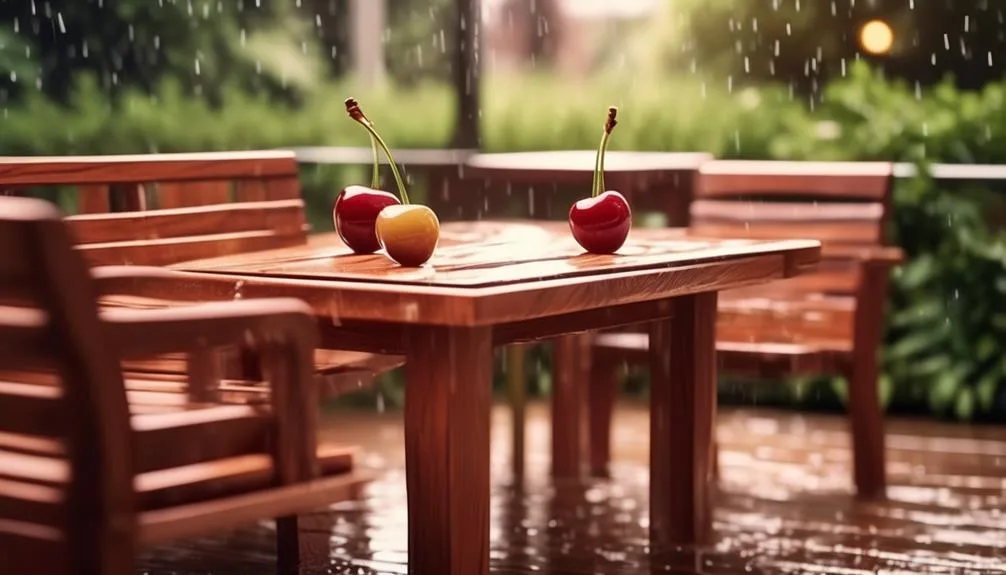Considering cherry wood for your outdoor furniture or decking? While it's known for its beautiful color and grain, its durability in outdoor conditions is up for debate.
Before you decide, it's important to weigh the pros and cons. There's more to this than meets the eye, and you'll want to be well-informed before making any decisions.
Cherry Wood Characteristics
Cherry wood is known for its rich, reddish-brown color and smooth, fine grain, making it a popular choice for furniture and interior woodworking projects. The color of cherry wood deepens with age and exposure to light, creating a warm and inviting atmosphere in any space.
Its grain patterns are distinct and add a touch of elegance to any woodworking project. In terms of durability, cherry wood is moderately hard and durable, making it suitable for indoor furniture. However, when used outdoors, cherry wood is prone to weathering and may require regular maintenance to preserve its appearance and structural integrity.
It's essential to consider these characteristics when deciding whether cherry wood is suitable for outdoor use, as it may not withstand the elements as well as other wood species.
Outdoor Exposure Impact
Considering the impact of outdoor exposure on cherry wood, it's important to recognize the potential effects of weathering and the necessary maintenance to uphold its appearance and structural integrity.
Weather resistance is a crucial factor in determining cherry wood's durability for outdoor use. Cherry wood is moderately resistant to decay, but it may still be susceptible to warping, cracking, and fading when exposed to constant moisture and sunlight. To mitigate these effects, regular sealing and protective coatings are essential to maintain its longevity.
Natural aging is another consideration when using cherry wood outdoors. Over time, cherry wood develops a rich, dark patina due to exposure to UV rays and environmental elements. While this aging process can enhance its aesthetic appeal, it's important to understand and embrace the natural changes that occur with outdoor exposure.
Cherry Wood Maintenance
To maintain cherry wood's durability for outdoor use, regular sealing and protective coatings are essential to mitigate the effects of weathering and uphold its appearance and structural integrity. Cherry wood sealing is crucial for protecting the wood from moisture, UV rays, and temperature fluctuations. Opt for a high-quality outdoor wood sealant and apply it as directed to create a barrier against the elements.
Additionally, consider using a protective coating specifically designed for cherry wood to enhance its weather resistance. Regularly inspect the wood for any signs of wear or damage, and reapply sealant and protective coatings as needed to ensure long-lasting durability.
Alternatives for Outdoor Use
When selecting wood for outdoor use, it's important to consider alternatives that offer durability and weather resistance. Here are three great options to consider:
- Teak Furniture: Known for its natural oils and high rubber content, teak is highly resistant to moisture, rot, and insects. It's a popular choice for outdoor furniture due to its ability to withstand harsh weather conditions.
- Cedar Furniture: Cedar is naturally resistant to decay, rot, and insect damage. Its distinct aroma acts as a natural insect repellent, making it an excellent choice for outdoor furniture that's both durable and aesthetically pleasing.
- Redwood Furniture: Redwood is naturally resistant to decay and insects, making it a durable choice for outdoor furniture. Its beautiful reddish-brown color and resistance to warping make it a popular option for outdoor use.
Consider these alternatives when looking for durable and weather-resistant wood for your outdoor furniture needs.
Expert Recommendations
If you're seeking expert recommendations for durable and weather-resistant wood for your outdoor furniture, it's essential to explore options that offer both longevity and aesthetic appeal.
When it comes to weather resistance, teak and cedar are top choices. Teak is naturally weather-resistant and requires minimal maintenance, while cedar contains natural oils that make it resistant to rot and insects. Both woods age beautifully, developing a silvery patina over time.
As for finish options, marine-grade varnishes and outdoor-specific oils are recommended to enhance the wood's natural resistance to the elements. These finishes provide an additional layer of protection, ensuring that your outdoor furniture withstands the rigors of sun, rain, and temperature fluctuations.
Conclusion
Considering cherry wood's susceptibility to rot, decay, and insect damage, it may not be the best choice for outdoor use. Exploring alternative woods or outdoor materials recommended by experts can ensure long-lasting and low-maintenance outdoor furniture and structures.
What materials will you choose for your outdoor projects?

My interest in trees started when I first saw the giant sequoias in Yosemite.
I was a teenager then, and I remember thinking, “I need to learn more about this.”
That moment stuck with me.
A few years later, I went on to study forestry at Michigan Tech.
Since graduating, I’ve worked in a mix of hands-on tree care and community education.
I’ve spent over ten years helping people understand how to plant, maintain, and protect the trees in their neighborhoods.
I don’t see trees as just part of the landscape.
They are living things that make a real difference in our daily lives.
